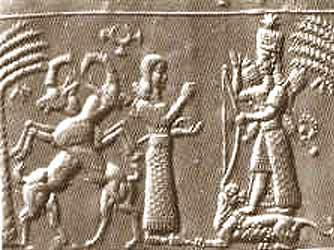Trinities versus Male-Female Dualism
“The early importance and supremacy of Erech in Semitic Babylonia caused its god to assume a place by the side of Ea of Eridu and Mul-lil, the older Bel. It is possible that the extension of his cult had already begun in Accadian days. The Ana, or Sky-god, to whom Gudea at Tel-loh erected a temple, may have been the Sky-god of Erech, more especially when we remember the connection that existed between Erech and Eridu on the one hand, and between Tel-loh and Eridu on the other.
However this may be, from the commencement of the Semitic period Anu appears as the first member of a triad which consisted of Anu, Bel or Mul-lil, and Ea. His position in the triad was due to the leading position held by Erech; the gods of Nipur and Eridu retained the rank which their time-honoured sanctity and the general extension of their cult had long secured to them; but the rank of Anu was derived from the city of which he was the presiding god.
The origin of the triad was thus purely accidental; there was nothing in the religious conceptions of the Babylonians which led to its formation. Once formed, however, it was inevitable that a cosmological colouring should be given to it, and that Anu, Bel and Ea, should represent respectively the heaven, the lower world and the watery element.
Later ages likened this cosmological trinity to the elemental trinity of the Sun, the Noon and the Evening Star; and below the triad of Anu, Bel and Ea, was accordingly placed the triad of of Samas, Sin and Istar. But this secondary trinity never attracted the Babylonian mind.

This finely cut seal depicts Ishtar, Mesopotamian goddess of sexuality and warfare.
Her strength as a warrior is stressed here, as she is shown with weapons rising from her shoulders.
Ishtar appears to have been associated at an early period with the Sumerian goddess Inanna and both deities are depicted with symbols of fertility, such as the date palm, and of aggression, such as the lion.
This iconography survived relatively unchanged for over a thousand years. Here, Ishtar’s astral quality is also emphasized: above her crown is a representation of the planet Venus.
In the first millennium BC more unusual stones were used to make seals: this one is made of green garnet, which may have come from northern Pakistan. British Museum, ME 89769, acquired 1835.
D. Collon, First impressions: cylinder seals (London, The British Museum Press, 1987)
H. Frankfort, Cylinder seals (London, Macmillan, 1939)
http://www.britishmuseum.org/explore/highlights/highlight_objects/me/g/garnet_cylinder_seal_ishtar.aspx
Up to the last, as we have seen, Sin continued to be the father of Samas and Istar, and Babylonian religion remained true to its primitive tendency to dualism, its separation of the divine world into male and female deities.
The only genuine trinity that can be discovered in the religious faith of early Chaldea was that old Accadian system which conceived of a divine father and mother by the side of their son the Sun-god.
The Semitic Anu necessarily produced the feminine Anat, and as necessarily Anat was identified with the earth as Anu was with the sky. In this way the Accadian idea of a marriage union between the earth and the sky was adapted to the newer Semitic beliefs. But we must not misunderstand the nature of the adaptation.
Anat never became an independent deity, as Dav-kina, for example, had been from the outset; she had no separate existence apart from Anu. She is simply a Bilat matati, “a mistress of the world,” or a Bilat ili, “a mistress of the gods,” like the wife of Bel or of Samas: she is, in fact, a mere colourless representation of the female principle in the universe, with no attributes that distinguish her from Anunit or Istar except the single one that she was the feminine form of Anu.

Goddess Ishtar, center, with wings, standing armed with one foot on a lion, her symbol.
The goddess is portrayed wearing the horned headdress of divinity and indistinct weaponry on her back.
Hence it is that the Canaanites had not only their Ashtaroth, but their Anathoth as well, for the Anathoth or “Anats” differed from the Ashtaroth or “Ashtoreths” in little else than name. So far as she was an active power, Anat was the same as Istar; in all other respects she was merely the grammatical complement of Anu, the goddess who necessarily stood at the side of a particular god.”
A.H. Sayce, Lectures on the Origin and Growth of Religion as Illustrated by the Religion of the Ancient Babylonians, 5th ed., London, 1898, pp. 192-4.
